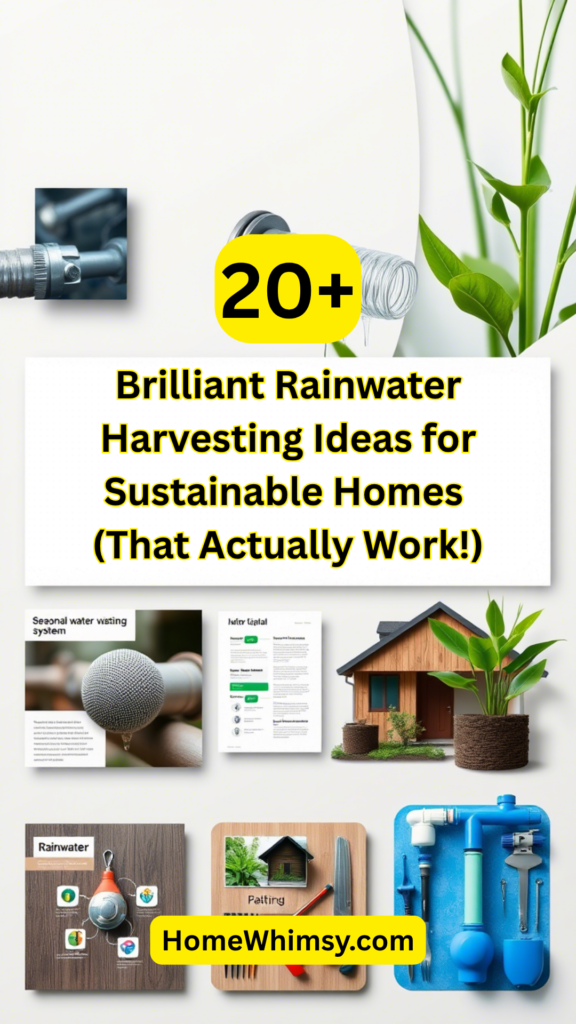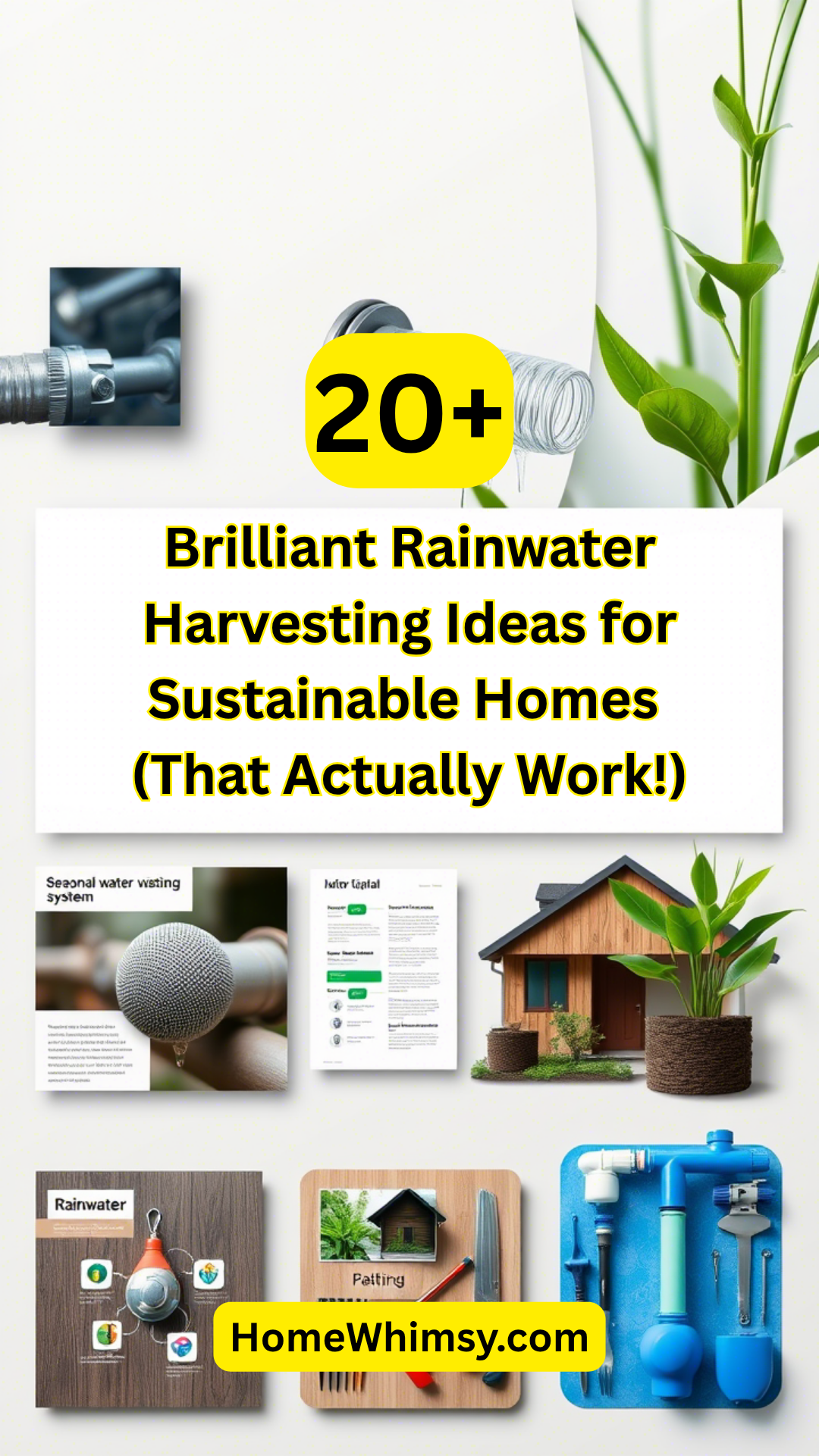Imagine a world where your home doesn’t just consume resources, but gives back to the environment. Where every drop of rain that falls on your roof becomes a lifeline for your garden, your household, and even your community. That’s the power of Rainwater Harvesting.
In a time when water scarcity is becoming a global crisis, collecting and reusing rainwater isn’t just eco-friendly—it’s essential. Whether you’re living off-grid, building a sustainable homestead, or simply want to reduce your utility bills, harvesting rainwater can be a game-changer.
This article brings together the most creative, practical, and visually stunning rainwater harvesting ideas from across Pinterest—each one tested, explained, and curated to help you transform your home into a water-wise sanctuary. From sleek DIY systems to underground reservoirs, we’ve got something for every budget, space, and lifestyle.
Ready to dive in? Let’s explore how you can start saving water today—and maybe even inspire others along the way.
📌 Save this pin for later!
📌 Want more ideas like this? Follow me @homewhimsy
Water Recycling in Eigen Tuin

This Dutch-inspired backyard setup shows how homeowners can integrate water recycling directly into their gardens. The system collects rainwater from rooftops and channels it into a filtration unit before being used for irrigation and cleaning purposes.
Why It Works:
- Combines aesthetics with functionality
- Uses natural plant filters to purify water
- Perfect for small urban gardens
Pro Tip:
You can use gravel beds and aquatic plants like reeds or water lilies to naturally filter your harvested rainwater before reuse.
Water Conservation in Off-Grid Living: The Lifeline of Autonomy and Resilience

For those living off the grid, water conservation is not optional—it’s survival. This image highlights an integrated rainwater system designed specifically for self-sufficient homes. The setup includes rooftop collection, storage tanks, UV purification, and gravity-fed distribution for indoor use.
Why It Works:
- Provides clean water without municipal connection
- UV purification ensures safe drinking water
- Gravity-fed design reduces energy needs
Pro Tip:
Pair your system with solar-powered pumps for full independence from the grid.
Rainwater Harvesting: Sustainable Home Water Solutions

This modern home integrates a complete rainwater harvesting system into its architecture. Gutters lead to large underground cisterns that store water for both indoor and outdoor use. Smart sensors monitor levels and automatically switch to municipal backup if needed.
Why It Works:
- Seamlessly blends into home design
- Smart technology ensures reliability
- Reduces monthly water bills significantly
Pro Tip:
Use overflow valves to redirect excess water into garden beds during heavy rains.
Collect Rainwater: Eco-Friendly Harvesting

This simple yet effective system uses a basic gutter-to-barrel setup. A fine mesh screen keeps debris out while allowing maximum water flow. The barrel has a spigot at the bottom for easy access to water for gardening or car washing.
Why It Works:
- Low cost and easy to install
- Ideal for beginners
- Can be expanded over time
Pro Tip:
Elevate the barrel on a platform so you can attach a hose or fill watering cans easily.
Decor & Architectures | Rainwater harvesting is a fantastic and eco-friendly way to conserve water and reduce reliance on municipal water supplies | Facebook

This photo shows how rainwater systems can double as architectural features. A sculptural downspout leads water into a decorative stone basin that doubles as a fountain and water storage unit.
Why It Works:
- Turns functional elements into art
- Encourages mindfulness about water use
- Great conversation starter
Pro Tip:
Add fish or floating plants to your basin to create a mini ecosystem.
Discover The Benefits Of Rainwater Harvesting: Save Money, Conserve Water, And Support Sustainability

This infographic-style image clearly outlines the core benefits of rainwater harvesting. From reducing water bills to lowering dependence on municipal supplies and helping the environment, it’s a powerful visual reminder that every drop counts.
Why It Works:
- Presents complex data in an easy-to-digest format
- Motivates homeowners to take action
- Great for sharing on social media or educational purposes
Pro Tip:
Create your own version of this chart to track how much water you save each month using your system!
How to harvest rainwater — and why you want to — The Washington Post

This Washington Post feature highlights a suburban home with a fully integrated rainwater harvesting system. The article explains how even city dwellers can benefit from collecting and reusing rainwater, especially for outdoor uses like gardening and car washing.
Why It Works:
- Shows real-world application in urban settings
- Encourages small-scale adoption
- Backed by credible journalism
Pro Tip:
Start small—install a single barrel under one downspout and expand as you see results.
Wahaso Water Harvesting Systems For Commercial Buildings

This image showcases a large-scale commercial rainwater harvesting system installed in an office building. The system collects rooftop runoff, filters it through multiple stages, and then uses it for toilet flushing, cooling towers, and landscape irrigation.
Why It Works:
- Demonstrates scalability of rainwater systems
- Reduces commercial water costs significantly
- Meets green building certifications (like LEED)
Pro Tip:
Residential users can adopt similar principles at smaller scales—like filtering and storing water for non-potable indoor use.
Off-Grid Living: Power, Water & Waste Solutions for a Self-Sufficient Life

This photo illustrates a complete off-grid homestead setup that includes solar panels, compost toilets, greywater recycling, and a robust rainwater harvesting system. Together, they form a closed-loop resource cycle that mimics natural ecosystems.
Why It Works:
- Offers a holistic approach to sustainability
- Each system supports the other
- Ideal for rural or remote locations
Pro Tip:
Use collected rainwater to flush compost toilets or power biogas generators in advanced setups.
Rainwater Harvesting Techniques for Home Gardens

This image shows a simple yet effective garden-based rainwater harvesting method. A series of swales and trenches capture rainfall and allow it to slowly seep into the soil, nourishing plants and improving groundwater recharge.
Why It Works:
- Prevents runoff and erosion
- Improves soil moisture retention
- Requires minimal infrastructure
Pro Tip:
Plant deep-rooted native species along swales to help absorb and filter rainwater naturally.
Rainwater harvesting is Pinterest’s gardening craze for 2023 — here’s how to do it

This popular Pinterest post features a step-by-step guide to setting up a basic rainwater collection system. It includes tips on choosing containers, installing overflow outlets, and connecting to drip irrigation lines.
Why It Works:
- Beginner-friendly instructions
- Highly visual and engaging layout
- Shares practical tools and materials
Pro Tip:
Add a fine mesh screen and first-flush diverter to improve water quality for edible gardens.
Rainwater Collection Regulations: What You Need to Know Before You Start

This informative graphic explains local laws and regulations around rainwater harvesting in various U.S. states. Some areas have restrictions or require permits, so it’s essential to check before installing any system.
Why It Works:
- Provides legal clarity
- Helps avoid fines or removal orders
- Empowers informed decision-making
Pro Tip:
Contact your local water authority or building department for specific guidelines in your area.
DIY Rainwater Harvesting

This DIY project features a custom-built rainwater collector made from repurposed materials. The setup includes a gutter extension, mesh filter, and a gravity-fed spigot—all housed in a wooden enclosure that blends with the backyard.
Why It Works:
- Cost-effective and customizable
- Uses readily available materials
- Looks good while doing good
Pro Tip:
Paint or stain the wooden enclosure to match your house for a seamless look.
17 Aesthetic Rainwater Systems That Don’t Look Like Barrels

This pin introduces stylish alternatives to traditional rain barrels. From sculptural fountains to wall-mounted cisterns and planter-integrated tanks, these designs prove that function doesn’t have to sacrifice form.
Why It Works:
- Appeals to design-conscious homeowners
- Increases curb appeal
- Hides functionality behind beauty
Pro Tip:
Use vertical space to install hidden tanks that double as trellises or seating walls.
Collecting Rainwater

This minimalist setup demonstrates how anyone can start collecting rainwater with just a few buckets or containers placed strategically under downspouts. It’s a great way to get started without investing heavily upfront.
Why It Works:
- No special equipment needed
- Perfect for renters or apartment dwellers
- Easy to move and store
Pro Tip:
Use food-grade containers with tight-fitting lids to keep water clean and mosquito-free.
Rainwater Harvesting: Collecting and Using Water Sustainably

This diagram-rich image breaks down the entire process of rainwater harvesting—from collection on rooftops to filtration, storage, and final usage. Each component is labeled and explained, making it ideal for beginners.
Why It Works:
- Teaches the science behind the system
- Helps troubleshoot common issues
- Encourages experimentation and learning
Pro Tip:
Label your own system components for easier maintenance and teaching others.
What Is Rainwater Harvesting | Rainwater Harvesting Methodology

This educational poster defines rainwater harvesting and explores different techniques such as rooftop catchment, surface runoff harvesting, and artificial recharge methods. It also discusses the importance of sustainable water management.
Why It Works:
- Comprehensive overview
- Great for classrooms or community centers
- Promotes awareness and education
Pro Tip:
Print and display this poster in your garage or shed as a reference while maintaining your system.
Harvest Rainwater to Quench Your Homestead’s Thirst

This rustic homestead setup shows how a family uses a combination of metal barrels, underground cisterns, and gravity-fed irrigation to sustain their livestock, garden, and household needs throughout the year.
Why It Works:
- Reliable water source in dry seasons
- Supports self-sufficiency goals
- Reduces dependency on wells
Pro Tip:
Connect multiple barrels together to increase storage capacity during heavy rains.
12 Simple Ways to Gather Rainwater That Will Change How You Use Water!

This vibrant pin lists 12 creative ways to collect rainwater, including funnels, bottles, decorative urns, and even kiddie pools. It encourages people to think outside the barrel when designing their systems.
Why It Works:
- Fun and imaginative
- Adaptable to any budget
- Encourages reuse of old items
Pro Tip:
Try turning an old wine barrel into a charming rainwater collector!
Rainwater Harvesting: Weighing Costs Vs. Benefits

This comparative chart helps viewers understand the initial investment versus long-term savings of installing a rainwater harvesting system. It considers factors like installation cost, maintenance, water bill reduction, and environmental impact.
Why It Works:
- Clear financial breakdown
- Helps justify the expense
- Shows return on investment over time
Pro Tip:
Factor in potential rebates or tax incentives when calculating your costs.
📌 Want more sustainable living ideas? Follow me on @homewhimsy for daily inspiration!
Have you tried any of these rainwater harvesting methods at home? Share your experience in the comments below or tag us in your photos—we’d love to see how you’re making a difference!










